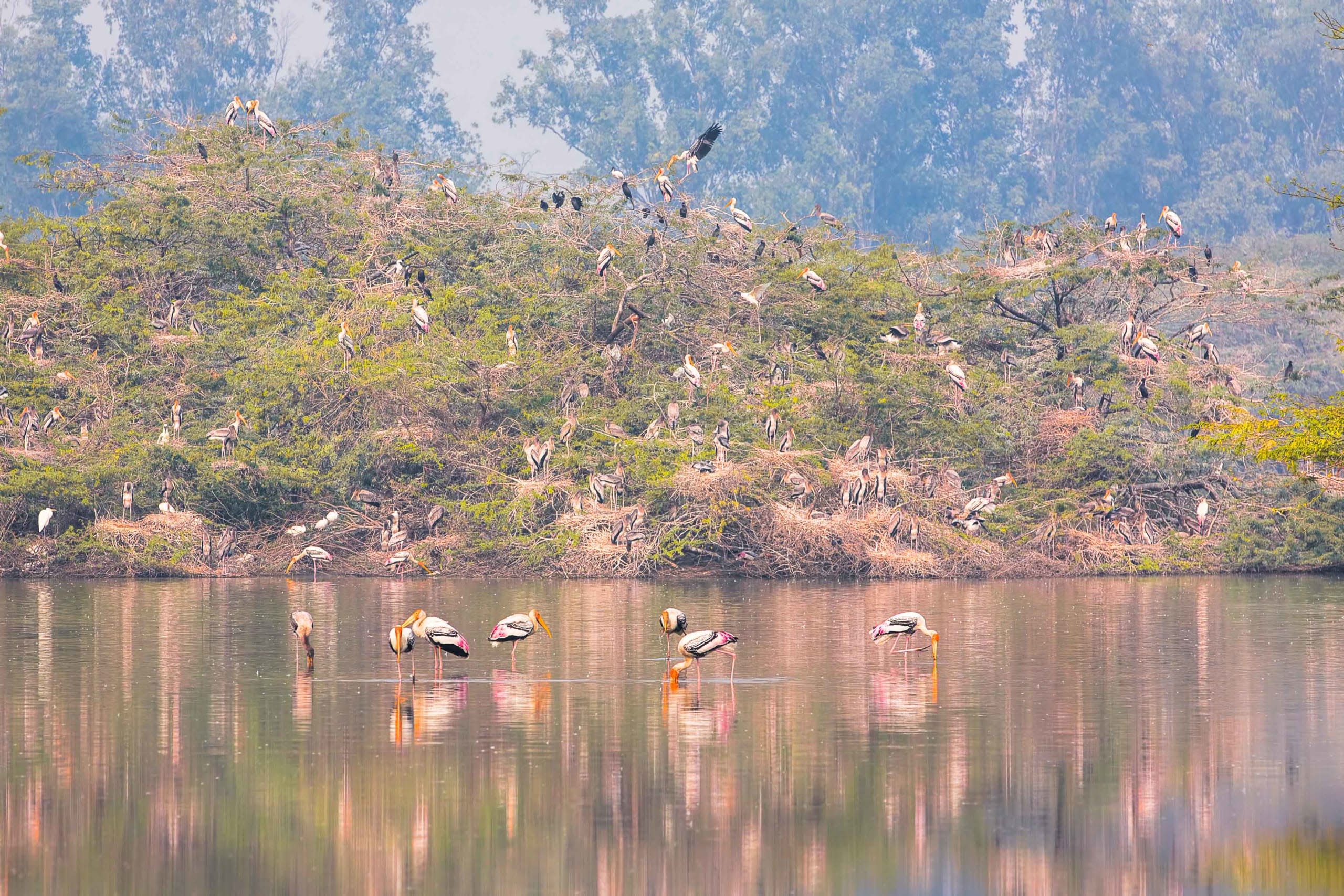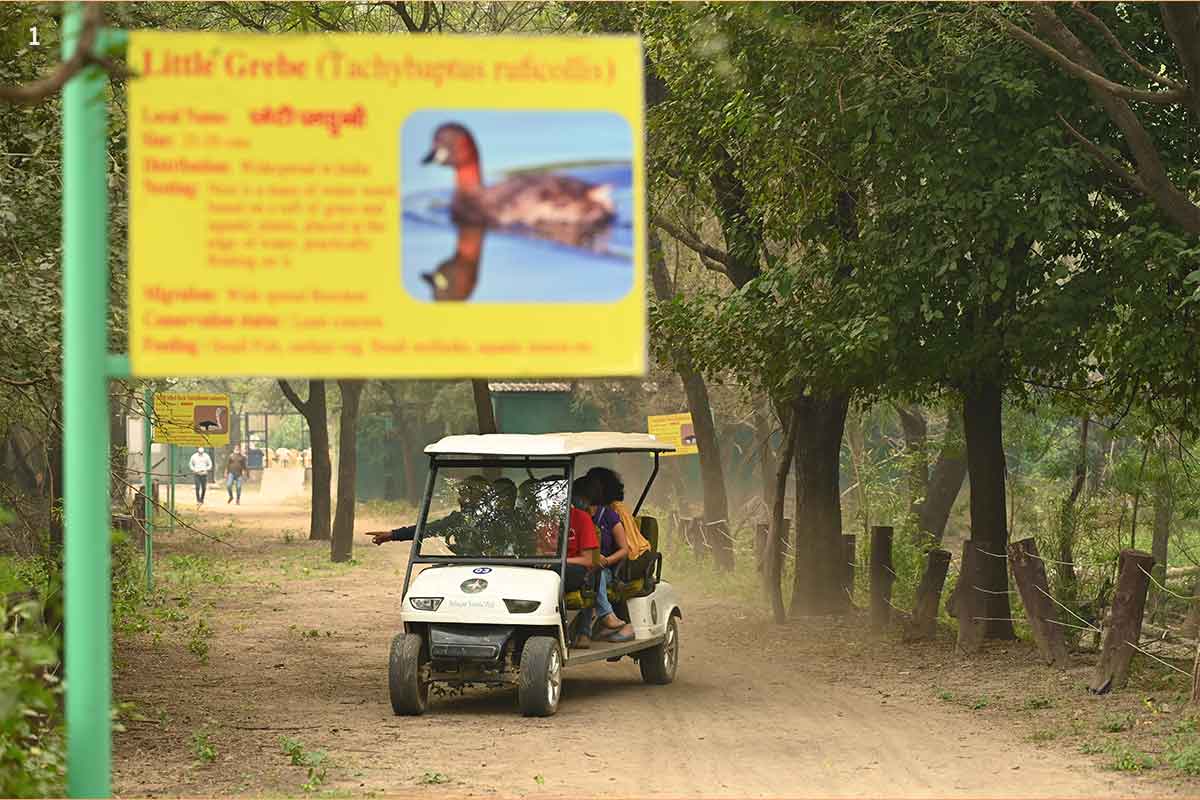 Listen to this article
•
15:34 min
Listen to this article
•
15:34 min
At a certain time of year, gold creeps into the frames of birdwatchers in North India. It’s the gilt of Bollywood frames, the molten-liquid swathe of mustard fields. Hundreds of thousands of eye-watering yellow flowers sway in the crisp winter air. If you see photos of birds with mustard flowers (around Delhi), they are likely to be from around Sultanpur National Park, a newly declared Ramsar site that sits like a bowl between agricultural landscapes. At 75, India now has 75 Ramsar sites, many of which have been designated in 2022.
Sultanpur is in Haryana, but because it is close to the Capital’s border, it also enjoys attention from Delhi. Ornithologist Salim Ali spent time in Sultanpur with fellow bird scientist Dillon Ripley and made a strong case for Sultanpur’s protection. Decades later, the National Park continues to receive tourists who want to get away from urban life and those visiting to view resident and migratory birds.
Cover photo: Painted storks forage in the waters of Sultanpur, an important breeding location for them. In the background is a full-fledged heronry. Cover photo: SoumenNath/Getty Images
The first time I went to Sultanpur, I expected to see migratory redstarts, flycatchers, eagles, and perhaps a towering crane. I walked on an undulating trail full of people taking selfies. The first wild creature I saw was neither migratory nor winged — instead, it was a female nilgai, Asia’s largest antelope, smack in the middle of Sultanpur’s wetland. She looked completely at ease with her body submerged, and her face and neck turned towards me. Her eyes appeared half-closed in the almost-winter sunshine, her fur gelling into the water like she was a fish. She didn’t have the normal antelope skittishness. The lake could have been her jacuzzi; she felt safe because she was in the water, not on land. Right next to her, a cattle egret, snowy white and expectant, waited to climb her back and snack on ticks. Sultanpur is predominantly a wetland — now a Ramsar site of global importance — so what was a nilgai, a savanna animal, doing there? The answer lies in the fields around Sultanpur and that this wetland benefits from agricultural biodiversity. Birds and animals like sarus cranes and nilgai move between farms and water, transitioning effortlessly between wetter lands and hard ground. Areas around Sultanpur, including Budhera, Chandu, and Najafgarh, are important birdwatching locations.
Fields are perhaps not what people expect around cities, but many do have agricultural tracts around them. Recent research has shown that farmlands are extremely important for birdlife. Sadly, even as Sultanpur gets vaulted as a Ramsar site, it faces land use change that will significantly alter the area. Proposals for a 21-hectare university and hospital and two different housing complexes have received clearances from the state forest department and are likely to be cleared by the National Board for Wildlife.

As the girth of cities expands, planners turn their gaze to open areas, forests, wetlands, and eco-sensitive zones of national parks or sanctuaries. Recently, the Supreme Court directed that all protected areas should have at least one kilometre of eco-sensitive zones (ESZ). These zones are meant to act as a buffer or transition between a protected area and human activities. This is to avoid direct pollution and disruption of ecological services and wildlife movement.
According to a set of guidelines issued by the Ministry of Environment, Forests and Climate Change in 2007, certain activities are prohibited in ESZs: commercial mining, polluting industries, major hydroelectric projects, commercial use of wood and natural resources, and so on.
At first glance, a housing project and hospital planned in Sultanpur’s ESZ appear more benevolent than commercial logging. However, even housing or hospitals can cause substantial damage to a wetland. One question is, where will all the sewage go (this is a major source of pollution in rural wetlands)? The other is: How will biomedical waste be handled or moved? And we know how entities like housing societies expand over time. Roads that flatten vegetation, vehicles that knock over wildlife, lights that cause animal confusion or disorientation, and invasive species that spread because of people (including domestic dogs, cats, and rodents) are all threats to wild populations and wetlands.
The 75 wetlands comprising India’s Ramsar sites (including over 20 sites designated in 2022) showcase the country’s unusual and rich areas. We’ve got Thane Creek, next to sprawling metropolitan Mumbai, spilling over with toxins and noise. There is Pallikaranai in Chennai, a recipient of the city’s waste. Vedanthangal, India’s oldest bird sanctuary, faces an interesting question. An existing pharmaceutical company within the wetland wants to expand its operations. A case has been filed in the NGT challenging this expansion because, clearly, chemicals and life-sustaining water should not mix. Now that Vedanthangal has an elevated status as a wetland of global importance, how will the state safeguard the site?
It is a question similar to Sultanpur’s —what are the hard limits we will set to save wetlands of global importance? Why do we take away the “wet” from wetlands or make our best places the dirtiest?
Some of my best birding experiences in Delhi-NCR have been around Sultanpur, both in the migratory season and beyond. Near Chandu village, a water treatment plant, agricultural fields, and proximity to Sultanpur park create a rich tapestry that birds love. On my last visit, I watched greater flamingos stand in gleaming lines, their upturned bills immersed in muddy water as they searched for food. Pied mynas shrieked as they gathered nesting material to make nests in papdi (Holoptelea integrifolia) trees in the fields. Painted storks flew low in the blue sky, looking like confetti. Prinias called, and green bee-eaters zipped through the air on hunting sorties. A little further, the path seemed speckled. This was the texture of a group of living beings—small pratincoles standing perfectly still on the path. I stopped my car. The pratincoles deserved to stay for as long as they wished, and I would halt my journey. To a bird, the area could be one huge wetland —with patches of water flashing from fields, monsoon runoffs, a lake, and the water treatment area. Perhaps for a waterbird, the world is water and islands of land are exceptions.

In 2022, the endangered Indian skimmer, a bird that favours rivers, was in the Chandu area. This is an important development. The Indian skimmer is a black-and-white bird with an orange bill, and most of its breeding habitat lies in India. In its breeding stronghold, the Chambal River, spanning Uttar Pradesh, Madhya Pradesh, and Rajasthan, pairs are constantly threatened by sand mining and predation by free-ranging dogs. But the birds coming to Delhi-NCR mean they are willing to expand their lives to fit into places we no longer associate with endangered species. If the skimmers are in Chandu, they may come even closer to Sultanpur.
And this is the very idea of a Ramsar site: to be a place with multiple uses for humans and animals, to be a refuge for waterbirds, and an area with a gentle eco-sensitive zone that can leave a cultural and natural legacy.
If we plunge a thermometer into the depths of the waters, a fever diagnosis will come up if the water is surrounded by pharma, light, and noise pollution. The same device will come up cold and clean if we imagine low-impact eco-tourism, riparian trails, and organic agriculture instead. Let’s aim for land and water that’s not fevered. The Ramsar declaration is the first step – the second, even better one will be to stop the change of land use and let wetlands be wet, verdant, and uninterrupted.












